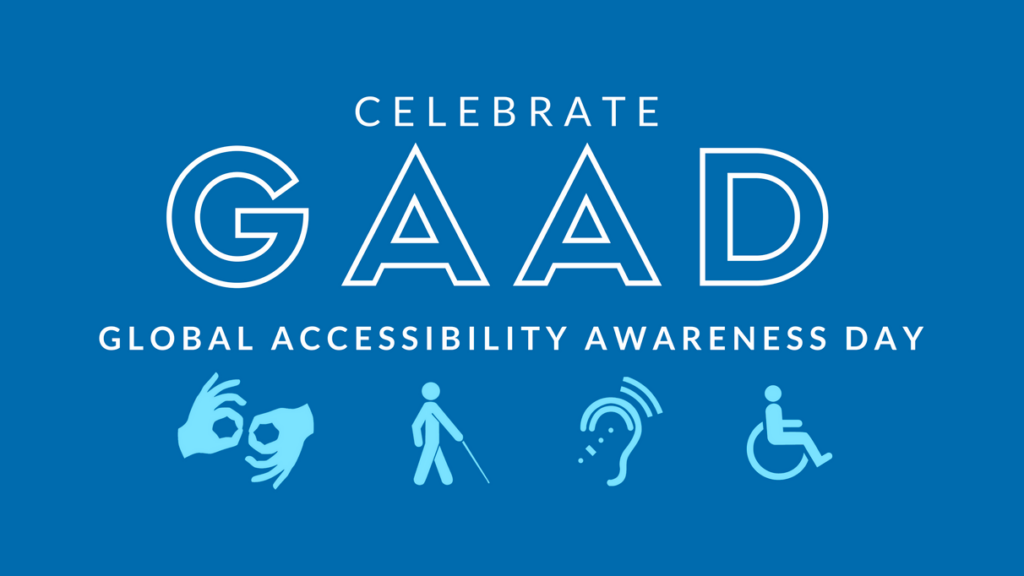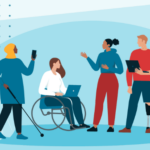
“The one argument for accessibility that doesn’t get made nearly often enough is how extraordinarily better it makes some people’s lives. How many opportunities do we have to dramatically improve people’s lives just by doing our job a little better?”
– Steve Krug
Introduction
The 12th Global Accessibility Awareness Day (GAAD) is on Thursday, May 18, 2023 worldwide. The main purpose of GAAD is to get everyone talking, thinking, and learning about digital access and inclusion. It helps to create a discussion around more than 1 billion people around the world who have a disability or impairment that rely on accessibility.
What is Global Accessibility Awareness Day (GAAD)?
Global Accessibility Awareness Day (GAAD) targets developers, designers, and other creators to focus more on digital accessibility and inclusion.
Where did the idea of GAAD come from?
The original inspiration for GAAD is a single blog post written by a web developer named Joe Devon back in 2011. He proposed for every developers to come together and work to bridge the accessibility gap by raising awareness and global standards.
Devon joined hands with Jennison Asuncion to bring the vision to life. GAAD continues to grow every year and has now reached the stage where people hold in-person and virtual events in six continents across the world.
It is inspiring to see an increasing number of people participate on this day to talk, think, and learn more about accessibility. And spread awareness about how the digital world (web, software, mobile, etc.,) can become more accessible and inclusive.
What is Digital Accessibility?
Every person deserves an accessible web experience. Someone with a disability must be able to experience web-based services and consume online content with the same positive outcome as those without disabilities. This awareness and commitment to inclusion is the number one goal of GAAD. Also a global event that shines a light on digital access and inclusion for people with disabilities.
State of Accessibility on the 12th GAAD Anniversary
In February 2022, WebAIM analyzed one million home pages for accessibility issues and found the following:

Causes of Most Common Accessibility Failures (% of Home Pages)

Population affected by Inaccessibility

Did you know? More than 1 billion people worldwide have some type of disability.
Common disabilities/impairments
- Visual – People who are blind need alternative text descriptions for meaningful images and use the keyboard and not a mouse to interact with interactive elements.
- Hearing – People who are deaf or hard of hearing will need captioning for video presentations and visual indicators in place of audio cues.
- Motor – People with motor impairments may need alternative keyboards, eye control or some other adaptive hardware to help them type and navigate on their devices.
- Cognitive – An uncluttered screen, consistent navigation and the use of plain language would be useful for people with different learning disabilities/impairments.
Why is it so important to be aware of accessibility on the occasion of GAAD?
There are plenty of obvious reasons that accessibility first matters. However, ultimately people with disabilities should have the same rights as the wider population. Not to mention that includes their ability to engage with, learn from, and communicate via the digital world.
When we take the responsibility to design for accessibility, we create more opportunities for disabled people to utilize disabled technology. And increase our market share and support diversity and inclusion across the board.
If you choose not to implement accessibility solely for financial reasons, it means you are acting illegally. To say nothing of short-sightedness in terms of the business value you can gain from accessible designs.
Of course you may have to contend with design and development backlogs, but that is no reason to not make progress on accessibility. Take small steps towards perfection.
Three Ways You Can Help Raise Disability Awareness
- Attend in-person, virtual, or private events
- Host your own events
- Participate in activities, initiatives, or projects
Here are some of the Common accessibility issues that you can fix today to remove barriers and unlock the possible
- Low Text Contrast: Ensure text and images of text have a contrast ratio of 4:5:1 and large-scale text have a contrast ratio of at least 3:1.
- Missing Alternate Text: All images require descriptive alternate text.
- Missing Form labels: Form inputs require proper meaningful labels.
- Missing Headings: Ensure tags for heading levels for screen readers.
- Ambiguous Links and buttons: Navigation links and buttons must be concise and free of ambiguity.
- Language: Ensure the language is specified on a web page or document.
- Missing Focus States: Assign focus state to all interactive elements that require a focus state on a web page.
- Missing captions and transcriptions: Accessible multimedia (visual and auditory content) must include captions which are text versions of speech and transcripts.
- Keyboard Only navigation: Facilitate keyboard-only use on web pages for easier navigation and user-specific needs.
Whom does this benefit?
- People who are blind need alternative text descriptions for meaningful images and use the keyboard and not a mouse to interact with interactive elements.
- People who are deaf or hard of hearing will need captioning for video presentations and visual indicators in place of audio cues.
- People with motor impairments may need alternative keyboards, eye control or some other adaptive hardware to help them type and navigate on their devices.
- An uncluttered screen, consistent navigation and the use of plain language would be useful for people with different learning disabilities/impairments.
GAAD – Accessibility Removes Barriers
Imagine if you cannot go into the places where you buy your groceries. Imagine not just being able to check when the train goes, what you need to know to file your tax return. All those things you use the web for every day, without even thinking about it.
Now imagine if someone says: “Yes, but you see the design is so much cleaner/more elegant/minimalist/etc., as it is now”. Or “I’m sorry, the budget didn’t extend to making this accessible.” Meanwhile, they can’t buy food or rail tickets, use government services, or do many of the things so many people take for granted on the web. In 2023, educate yourself about:
- Basic color contrast (and how to check contrast)
- Why it’s more complicated than producing text-only content
- Keyboard navigation principles
- Designing for people with cognitive difficulties (often overlooked in web accessibility)
And quit pretending that accessible web design is not your responsibility. Source: Chris Atherton – UX Collective
Conclusion
If we look at the progress made on accessibility over the past decade, it leaves a lot to be desired. But if each one of us, whether a designer, developer, tester or user, took it upon themselves to advocate, raise awareness, educate about accessibility, then we’re that much closer to a more inclusive future!
From all of us at codemantra, Happy Global Accessibility Awareness Day! Reach out to us: engage@codemantra.com








